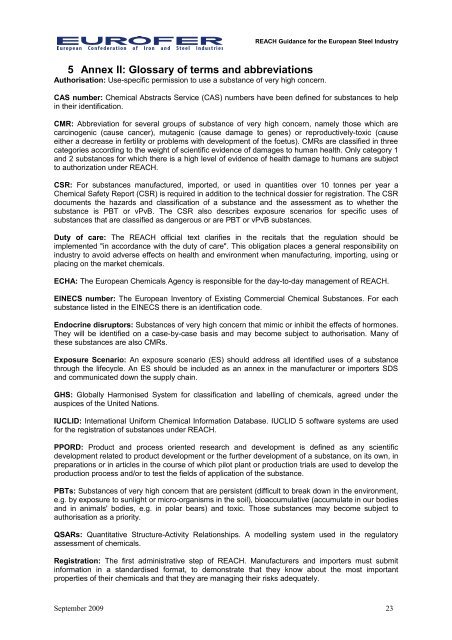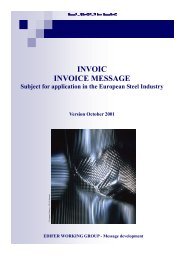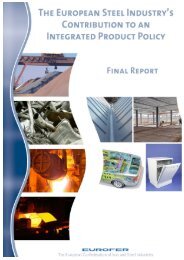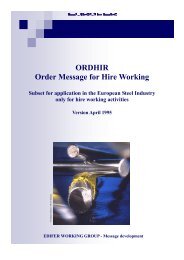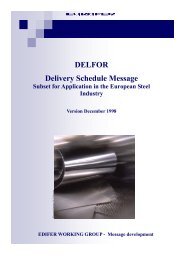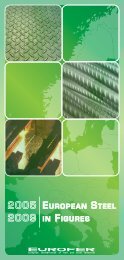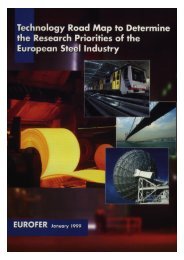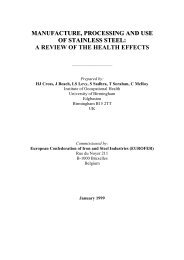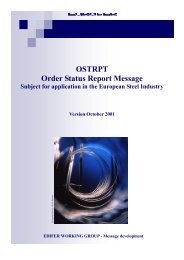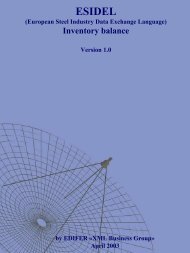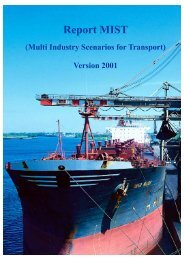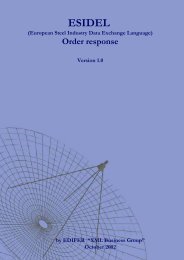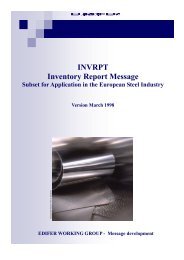EUROFER REACH guidance for the European Steel Industry. 09.09 ...
EUROFER REACH guidance for the European Steel Industry. 09.09 ...
EUROFER REACH guidance for the European Steel Industry. 09.09 ...
You also want an ePaper? Increase the reach of your titles
YUMPU automatically turns print PDFs into web optimized ePapers that Google loves.
<strong>REACH</strong> Guidance <strong>for</strong> <strong>the</strong> <strong>European</strong> <strong>Steel</strong> <strong>Industry</strong><br />
5 Annex II: Glossary of terms and abbreviations<br />
Authorisation: Use-specific permission to use a substance of very high concern.<br />
CAS number: Chemical Abstracts Service (CAS) numbers have been defined <strong>for</strong> substances to help<br />
in <strong>the</strong>ir identification.<br />
CMR: Abbreviation <strong>for</strong> several groups of substance of very high concern, namely those which are<br />
carcinogenic (cause cancer), mutagenic (cause damage to genes) or reproductively-toxic (cause<br />
ei<strong>the</strong>r a decrease in fertility or problems with development of <strong>the</strong> foetus). CMRs are classified in three<br />
categories according to <strong>the</strong> weight of scientific evidence of damages to human health. Only category 1<br />
and 2 substances <strong>for</strong> which <strong>the</strong>re is a high level of evidence of health damage to humans are subject<br />
to authorization under <strong>REACH</strong>.<br />
CSR: For substances manufactured, imported, or used in quantities over 10 tonnes per year a<br />
Chemical Safety Report (CSR) is required in addition to <strong>the</strong> technical dossier <strong>for</strong> registration. The CSR<br />
documents <strong>the</strong> hazards and classification of a substance and <strong>the</strong> assessment as to whe<strong>the</strong>r <strong>the</strong><br />
substance is PBT or vPvB. The CSR also describes exposure scenarios <strong>for</strong> specific uses of<br />
substances that are classified as dangerous or are PBT or vPvB substances.<br />
Duty of care: The <strong>REACH</strong> official text clarifies in <strong>the</strong> recitals that <strong>the</strong> regulation should be<br />
implemented "in accordance with <strong>the</strong> duty of care". This obligation places a general responsibility on<br />
industry to avoid adverse effects on health and environment when manufacturing, importing, using or<br />
placing on <strong>the</strong> market chemicals.<br />
ECHA: The <strong>European</strong> Chemicals Agency is responsible <strong>for</strong> <strong>the</strong> day-to-day management of <strong>REACH</strong>.<br />
EINECS number: The <strong>European</strong> Inventory of Existing Commercial Chemical Substances. For each<br />
substance listed in <strong>the</strong> EINECS <strong>the</strong>re is an identification code.<br />
Endocrine disruptors: Substances of very high concern that mimic or inhibit <strong>the</strong> effects of hormones.<br />
They will be identified on a case-by-case basis and may become subject to authorisation. Many of<br />
<strong>the</strong>se substances are also CMRs.<br />
Exposure Scenario: An exposure scenario (ES) should address all identified uses of a substance<br />
through <strong>the</strong> lifecycle. An ES should be included as an annex in <strong>the</strong> manufacturer or importers SDS<br />
and communicated down <strong>the</strong> supply chain.<br />
GHS: Globally Harmonised System <strong>for</strong> classification and labelling of chemicals, agreed under <strong>the</strong><br />
auspices of <strong>the</strong> United Nations.<br />
IUCLID: International Uni<strong>for</strong>m Chemical In<strong>for</strong>mation Database. IUCLID 5 software systems are used<br />
<strong>for</strong> <strong>the</strong> registration of substances under <strong>REACH</strong>.<br />
PPORD: Product and process oriented research and development is defined as any scientific<br />
development related to product development or <strong>the</strong> fur<strong>the</strong>r development of a substance, on its own, in<br />
preparations or in articles in <strong>the</strong> course of which pilot plant or production trials are used to develop <strong>the</strong><br />
production process and/or to test <strong>the</strong> fields of application of <strong>the</strong> substance.<br />
PBTs: Substances of very high concern that are persistent (difficult to break down in <strong>the</strong> environment,<br />
e.g. by exposure to sunlight or micro-organisms in <strong>the</strong> soil), bioaccumulative (accumulate in our bodies<br />
and in animals' bodies, e.g. in polar bears) and toxic. Those substances may become subject to<br />
authorisation as a priority.<br />
QSARs: Quantitative Structure-Activity Relationships. A modelling system used in <strong>the</strong> regulatory<br />
assessment of chemicals.<br />
Registration: The first administrative step of <strong>REACH</strong>. Manufacturers and importers must submit<br />
in<strong>for</strong>mation in a standardised <strong>for</strong>mat, to demonstrate that <strong>the</strong>y know about <strong>the</strong> most important<br />
properties of <strong>the</strong>ir chemicals and that <strong>the</strong>y are managing <strong>the</strong>ir risks adequately.<br />
September 2009 23


